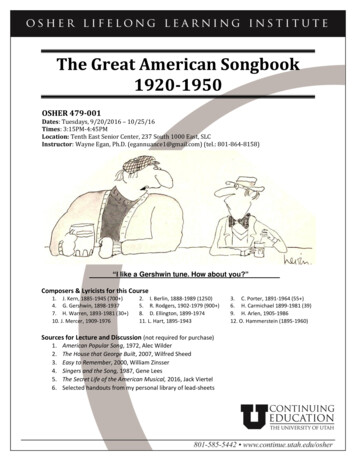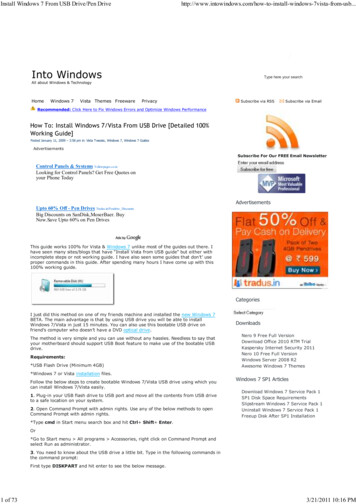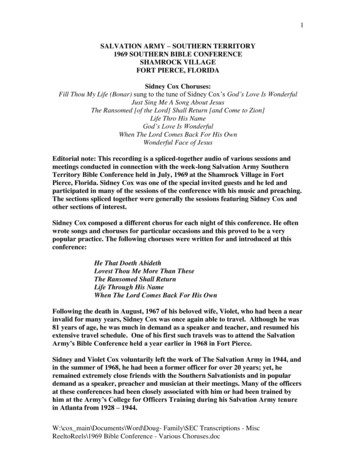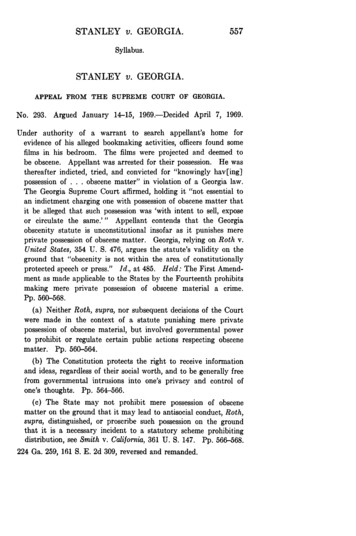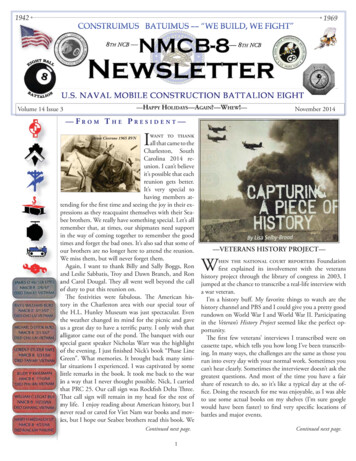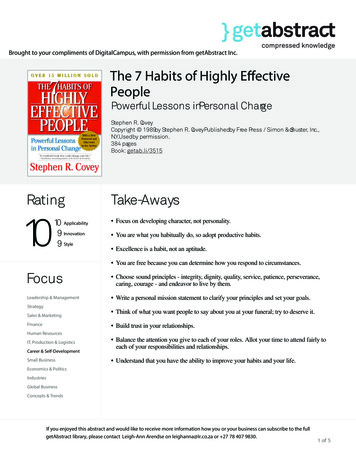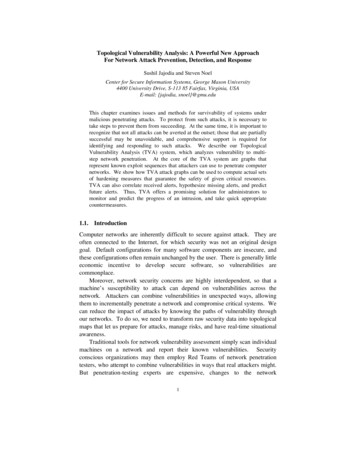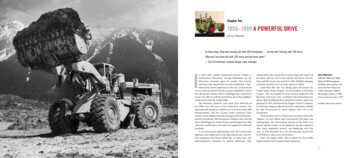
Transcription
Chapter Two1950–1969 A POWERFUL DRIVEBy Lee Klancher“In those days, they were moving dirt with 200 horsepower . . . yet we were farming with 100 horse.Why can’t we move dirt with 200 horse and get more done?”—Earl Christianson, original Steiger sales manager22RED 4WD TRACTORSAdams built a four-wheel-drive tractor using a 401 GMC V-6for power and two WD-9 rear ends for the drives. His son,Paul, said the tractor was at work in 1956. Multiple examplesof similar machines live in private collectors’ hands.Innovation like this was taking place all around theUnited States. Elmer Wagner and his brothers in Portland,Oregon, were surrounded by farm country peppered withbig farms with heavy soil—conditions that demanded morepower. They developed a four-wheel-drive tractor, which waspatented in 1953, and formed the Wagner Tractor Company.In 1954, the company offered three four-wheel-drive modelsfor sale, all powered by diesel engines with 114 to 165horsepower.While farmers such as Adams and innovators such as theWagners cut and welded steel, International Harvester wasmaking bank. The International tractors of the 1950s weremainly refined versions of old platforms, but the company’ssales reach, dealership network, and marketing were firstclass. In 1951, Harvester set a new all-time sales record with 1.28 billion in sales across all divisions.That’s the largest dollar sale in history by the world’slargest manufacturer of agricultural machinery.Heavy Machinery In 1950, rainy weather hammered Norman County innorthwestern Minnesota. Oswald Dallenbach was theMinnesota extension agent for nearby Clay County,and more than decade later, he still recalled how a fourwheel-drive tractor made news in the area. In Beyond theFurrow, historian Hiram Drache recounts Dallenbach’s tale ofhow the farmer’s Massey Harris Challenger four-wheel-drivetractor was able to work his land before any of his neighborscould venture into the muddy fields.The dreamers, schemers, and astute farm observers ofthe 1950s were well aware of four-wheel-drive tractors. Theideas and early machines could be seen in farm journals, fielddemonstrations, and the eccentric home mechanic’s backpasture. And as Steiger’s first sales manager, Earl Christianson,astutely pointed out, 200-horsepower machines were movingdirt to build highways. Smart farmers quickly figured out thatwith a few modifications, the same size equipment could workfarmland.A few particularly adept farmers took the Frankensteinapproach and melded parts from agricultural and construction equipment with home-welded bits to create their ownhigh-horsepower machines. In western Minnesota, AlanBy the 1950s and 1960s,plenty of 200-horsepowermachines were working—butnot on the farm. They werein the construction industry.This Hough is shown in 1964.Wisconsin Historical Society / 38127 Inset: Steiger Family Collection23
In 1955, Fortune magazine introduced the annual Fortune500 list, which listed the top 100 American companies rankedby gross sales. Allis-Chalmers and Caterpillar were the nearestcompetitors to International, and both had gross revenues thatwere roughly half that of Harvester. (Allis-Chalmers reported 492 million, and Cat came in at 401 million.)Harvester clocked in on the 1955 Fortune 500 list at No.22. Harvester was not just the world’s largest agriculturalcompany—it was one of the most powerful companies in theworld, with annual earnings comparable to Shell Oil, Kraft,Boeing, and RCA.That wasn’t to say all was well at Harvester. In fact, thebooming sales were a distraction from the changing needs ofFour-Wheel-Drive Dreams The demand for morepower and more tractionwas well established bythe mid-1950s, and lotsof companies—includingInternational Harvester—were experimenting withfour-wheel-drive machinery.Wisconsin Historical Society /130929Elwood Big 4 Tractor In the late 1950s, a number of manufacturers were building four-wheel-drive tractors. This Big 4 was built by Elwood, and these May1957 photographs in the IH collection indicate the Big 4 was studiedand possibly tested by IH. The 8,800-pound tractor had four-wheeldrive, four-wheel power steering, and air brakes.Wisconsin Historical Society / 2460024RED 4WD TRACTORSthe agricultural market, and decades of market dominationcreated arrogance that made the company vulnerable.The annual reports are telling on this front. Throughoutthe 1950s, Harvester’s reports to its investors highlighted newmodels and dollars pouring into research and development, ata time when the company was not doing enough R&D and the“new” models were evolutionary rather than truly innovative.In 1948, the company devoted 13 million to research anddevelopment. In 1956, Harvester spent 40 million ondeveloping new products.A portion of that was dedicated to the Farm EquipmentResearch and Engineering Center (FEREC) in Hinsdale,Illinois. This new building would be the largest engineeringfacility in Harvester history, and constructing it took fouryears and millions of dollars.The annual reports show hyperbole replacing innovationin the tractor line. In 1954, the “new” hundred series tractorswere touted as the first time in history an agriculturalcompany released an entirely new line of machines at onetime. The 1956 introduction of the “new” 350 and 450 weregiven equally laudatory language. Both releases were stylingand equipment upgrades to a chassis first introduced in theModel H and M back in 1939.By 1958, Harvester offered a truly new line of machineswith the 460 and 560. While the machines had great stylingand class-leading features, the largest model (the 560) offeredonly 59 horsepower. Harvester’s annual report promised the75-horsepower IH 660 was “coming soon,” touting it as “themost powerful tractor ever offered by the company.”Bear in mind the 73-horsepower Deere 820 had beenaround since 1956, and Oliver’s supercharged Model 995produced 84 horsepower. And the Wagner four-wheel-drivetractor model line—introduced in 1954—started at 114horsepower and went up to 160.Harvester was behind the times, and the early successof the big four-wheel-drive Wagner tractor, in particular,made a significant impact on the world’s leading agriculturalimplement company.A shake-up in management may have upgraded the levelof urgency placed on increased horsepower and traction.In 1958, John McCaffrey retired as CEO, and Frank W.Jenks stepped up. McCaffrey’s focus was sales, and while hedelivered on that front, he failed miserably to transform aheavy investment in development into meaningful traction inthe industry.Jenks would frankly not fare much better, but a rising starin the organization would start pushing the company in theright direction. Brooks McCormick, a direct descendant ofCyrus McCormick, the founder, was rising on the corporateladder. He was an executive vice president in the late 1950s.The Wagner tractor caught McCormick’s eye. He visitedthe Portland Harvester office on January 31, 1959, andpersonally requested that the district sales office find outexactly what was going on with the Wagner sales in the region.Exactly one week later, H. W. Berry reported that Wagner hadbeen producing machines for four years and had sold none inBerry’s territory in 1958. Berry not only found out that fivewere sold in 1959, but he also supplied the names of all fivecustomers.Berry apparently knew that when a descendant of CyrusMcCormick and a senior vice president show up at your door,you don’t ask when to jump—you ask how high.The notice of the Wagner coincided with a drive to get ahigh-horsepower machine on the market as quickly as possible.On February 20, 1959, an internal IH report was issued to theexecutive committee outlining a plan to introduce a Houghbuilt four-wheel-drive tractor with 90 to 100 horsepower.According to the report, Harvester executives had seen theexperimental tractor in action and believed it could ready formarket in less than a year.The report also surveyed farmers, county extensionagents, and specialists in farm management and agriculturalengineering. The results showed that a significant number ofAmerican farmers were interested in more horsepower andfour-wheel-drive tractors. Of farmers who owned 70- to 80horsepower tractors—the largest of the time—35 percent ofthem were interested in a four-wheel-drive machine.This report was one of a veritable blizzard of reportsin the archives concerning Wagner tractors, the Houghexperimental tractor, and the market for four-wheel-drivetractors. Another 1959 report shows evidence of considerablystronger sales of Wagner tractors, with H. W. Berry statingthat a Wagner employee told him production in 1959 wasbetween 300 and 400 units and was expected to be 600 to 800units in 1960. The most popular model in the Portland areawas the 160-horsepower TR-14, and it was, in fact, the onlymodel sold in that region to the sales director’s knowledge.1950–1969 A Powerful DriveHough 4WD-1 Frank G. Hough purchaseda heavy equipment company in1931 and renamed it the FrankG. Hough Company in 1933.The company built PayLoaderconstruction equipment andhad a four-wheel-drive versionon the market in 1948. He soldthe company to IH in 1952but remained an independentsubsidiary company. Houghtested this four-wheel-drivetractor in the 1950s, and IHwould introduce it as the 4300.Wisconsin Historical Society / 13092725
The 4300 was the mostpowerful tractor on the marketwhen it was introduced, andit was also a dismal salesfailure. Built by Hough forIH, the tractor was heavierand more expensive thanIH expected. Fewer than 504300s were built, and the rareplow in this image is evenharder to find. As of 2017,only one such plow is knownto exist. Wisconsin HistoricalSociety / 13093026Harvester representatives had spoken to farmers anddiscovered that the Wagners were replacing crawlers for twomain reasons: one, the machines sat up higher than crawlers, sothere was less dust; and two, farmers often had fields that wereas much as 20 miles apart, and the wheeled Wagners could bedriven on the road, while the crawlers had to be trailered.Zone manager Bob Weatherson reported that hepersonally knew of 20 sales of International TD-15 and TD20 crawlers that were lost to Wagner TR-14 tractors.Harvester product planner R. I. Throckmorton reportedthat the market was demanding a 100-drawbar-horsepower,four-wheel-drive tractor. In an IH memo dated May 21, 1959,he stated that farmers using IH 660s were having troubleswith inadequate traction. Larger-than-stock 18x26 tires costdouble the stock 15x34s, and adding wheel weights (also anexpensive option) proved inadequate.Throckmorton also discovered concern about a rumoredJohn Deere 100-horsepower tractor expected to be on themarket for 1960. It was likely a reference to the John Deere8010, a four-wheel-drive 100-horsepower machine thatperformed below expectations to say the least.A June 19, 1959, report from Hough to Harvester spelledout the status with the Hough experimental tractor, which wasdubbed the 4WD-1. In short, Hough was not able to meet manyof the Harvester specifications for a four-wheel-drive tractor.RED 4WD TRACTORSThe quest to fill the rapidly growing four-wheel-drivemarket continued. In November and December of 1962,V. O. Talbert spent four weeks visiting farms and IHdealerships from Kansas up to Minnesota and west to Oregonand Washington. His purpose was to measure demand fora high-horsepower, two-wheel-drive tractor like the newlyintroduced 109-drawbar-horsepower John Deere 5010 and forlarger four-wheel-drive tractors.Talbert reported that demand for the two-wheel-drivetractors was in the 80- to 90-horsepower range, as the 5010owners he spoke to were experiencing significant wheelslippage with the 109-horsepower two-wheel-drive machine.The interest in the large 4300 machine, according toTalbert, was low. “The 4300 size and price will seriouslyrestrict its acceptance and potential,” he wrote.He reported strong interest in a smaller, more versatilefour-wheel-drive tractor. “The largest demand is for FWD[four-wheel-drive] tractors is in the 110- to 120-drawbarhorsepower class,” he wrote in his report.Harvester responded quickly to this demand, and by thespring of 1963, engineer Harold Schramm was working todraw up the 4100. He did so in record time, mainly by creatingwhat is known as a component-built tractor.Building a new machine using existing components allows just about any company with a clever engineer and deepenough pockets to quickly create a machine using readilyavailable parts. A frame can be designed and constructed,and common components such as engines, transmissions, axles, brakes, wheels, and tires can be ordered from a supplier.The advantage of such a machine is that it can be designedPower Brokers IH 4300 and10-Bottom IH PlowThe 4WD-1 weight was 1 ton heavier than the specification. The desired retail price of 8,500 would have to rise to 18,000. No adjustable wheel tread was possible, a front powertake-off could not be added, and the hand clutch requested byfarmers in the survey was “not necessary.”The next memo in the archives from Hough to Harvesteris a lavish proposal for the 4WD-3, “the world’s mostpowerful four-wheel-drive agricultural tractor.” Houghsmelled opportunity and delivered a proposal that played upthe high horsepower of the machine and also played on thefears at Harvester that Deere was going to beat Harvester tothe punch.Dated September 16, 1960, the cover of the proposalis leather stamped with the IH logo and large, goldletters reading “CONFIDENTIAL.” Along with pages ofspecifications of the machine, the document contains anevaluation of the John Deere 8010. The Deere machine, itsaid, was announced in the fall of 1959, but as of September1960, it had not been made available.The 8010 proved so problematic that John Deere held themodels, rebuilt them, and released them as the 8020. At leastone experimental John Deere 8010 survived and is in privatehands, but the tractor never was released for f
Elwood Big 4 Tractor . available parts. A frame can be designed and constructed, and common components such as engines, transmissions, ax - les, brakes, wheels, and tires can be ordered from a supplier. The advantage of such a machine is that it can be designed The quest to fill the rapidly growing four-wheel-drive market continued. In November and December of 1962, V. O. Talbert spent four .
